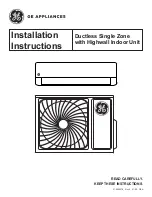
11
Installation Procedure
Note :
(1) Fix the parts with screws.
(2) Don't intake the strong wind directly to the outlet air-flow hole.
(3) A one meter distance should be kept from the unit top.
(4) Don't block the surroundings of the unit with sundries.
(5) If the outdoor unit is installed in a place that is exposed to the wind, install the unit so that the
outlet grid is NOT pointing in the direction of the wind.
Wind direction
NO
Installation of Outdoor Unit
Procedure for Selecting the Location
NOTE:
1) Choose a place solid enough to bear the weight and vibration of the unit, where the operation noise will not be amplified.
2) Choose a location where the hot air discharged from the unit or the operation noise, will not cause a nuisance to the
neighbors of the user.
3) Avoid places near a bedroom and the like, so that the operation noise will cause no trouble.
4) There must be sufficient space for carrying the unit into and out of the site.
5) There must be sufficient space for air passage and no obstructions around the air inlet and the air outlet.
6) The site must be free from the possibility of flammable gas leakage in a nearby place.
Locate the unit so that the noise and the discharged hot air will not annoy the neighbors.
7) Install units, power cords and inter-unit cables at least 10ft away from television and radio sets. This is to prevent
interference to images and sounds. (Noises may be heard even if they are more than 10ft away depending on radio wave
conditions.)
8) In coastal areas or other places with salty atmosphere of sulfate gas, corrosion may shorten the life of the air conditioner.
9) Since drain flows out of the outdoor unit, do not place under the unit anything which must be kept away from moisture.
10) On a flat surface that does not collect rain water.
11) Away from strong wind.
12) Away from direct exposure to rain or snow.
13) Away from sea breeze.
14) Away from inflammable materials.
1) Cannot be installed hanging from ceiling or stacked.
2) If installing on a high place such as a roof, with a fence or guard rail around it.
3) If there is a potential for accumulated snow to block the air inlet or heat exchanger, install the unit on a higher base.
4) R-410A refrigerant is a safe, nontoxic and nonflammable refrigerant. However, if there is a concern about a dangerous
level of refrigerant concentration in the case of refrigerant leakage, add extra ventilation.
5) Avoid installing the outdoor unit where corrosive gases, such as sulfur oxides, ammonia, and sulfurous gas, are produced.
If unavoidable, consult with an installation specialist about using a corrosion-proof or anti-rust additive to protect the unit
coils.
6) For seacoast applications, block the unit from direct exposure to sea breeze by installing the unit behind a structure
(such as a building) or a protective wall that is 1.5 times higher than the unit, leaving 28 in. (700 mm) of space between
the wall and unit for air circulation. Consult an installation expert about taking anti-corrosion measures, such as removing
salinity on the heat exchanger and applying a rust inhibitor more frequently than once a year.
ODU
ODU
ODU
ODU
Sea breeze
Sea breeze
Sea breeze
Sea
Sea
Sea
Protection walls
ODU
Summary of Contents for AW-YSDM048-H11
Page 18: ...Troubleshooting 18...
Page 20: ......






































